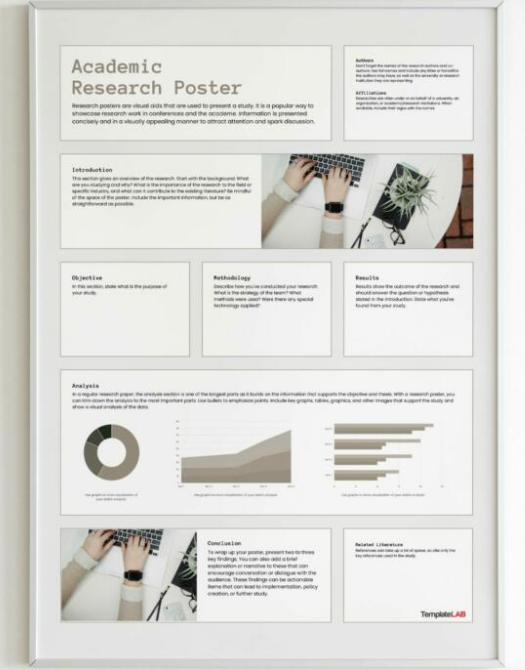An academic poster template is a pre-designed layout that provides a structure and visual framework for creating a poster presentation in academic or research setting. It serves as a starting point and guide for organizing content and presenting research findings, study methodology, or academic information in a visually appealing and informative manner.
Typically, academic poster feature sections or placeholders for different components of a poster, such as the title, introduction, objectives, methodology, results, discussion, conclusion, and references. These templates are designed to help researchers and academics effectively communicate their work and engage viewers at conferences, symposiums, or other academic events.
All in all, using academic poster can save time and effort by providing a consistent design, layout, and typography, ensuring a professional and cohesive appearance. It allows researchers to focus on arranging and presenting their content rather than starting from scratch to design the entire poster.
At the present time, academic templates are often available in popular design software like Microsoft PowerPoint or Adobe InDesign. They may come in different sizes, such as standard poster sizes (e.g., A0, A1, A2) or customizable dimensions.
Additionally, researchers can modify the template by adding their own content, adjusting the layout, changing colors, inserting images, graphs, and charts, and adapting the design to suit their specific research project and presentation goals.
As can be seen, by using academic poster template, researchers can create visually engaging and well-structured posters that effectively communicate their research findings and academic work to a wider audience.
How do I make an academic poster?
Unquestionably, creating academic poster involves several steps to ensure a visually appealing and informative presentation. Here’s a step-by-step guide on how to make academic poster:
Plan and Gather Content:
- Determine Poster Size and Orientation.
- Decide on the size and orientation of your poster, which may depend on the requirements of the conference or event.
- Common poster sizes include A0, A1, or letter size. Ensure that your chosen size is appropriate for the content and readability.
Choose Design Software:
- Select a design software that you are comfortable using, such as Microsoft PowerPoint, Adobe InDesign, or Canva.
- MS PowerPoint is widely accessible and offers robust design capabilities.
Set Up the Poster:
- Open a new document or slide in your chosen design software, selecting the dimensions corresponding to your poster size.
- Adjust the slide orientation to match your preferred layout (portrait or landscape).
Establish the Layout:
- Divide the poster into sections, such as introduction, objectives, methodology, results, discussion, conclusion, and references.
- Use text boxes, shapes, or placeholders to create distinct areas for each section.
Organize Content:
- Distribute your content evenly across the sections, ensuring a logical flow.
- Also, you can use bullet points, short sentences, and clear headings to make the text easily readable.
- Incorporate visuals like graphs, charts, and images to enhance understanding and engagement.
Design Template Elements:
- Choose an appropriate color scheme that aligns with your research and maintains readability.
- Use fonts that are clear and legible from a distance. Limit font variations and sizes to maintain consistency.
- Consider adding a background or border that complements the overall design without distracting from the content.
Review and Edit:
- Proofread the text for grammar, spelling, and clarity.
- Ensure that visuals and data are accurate and properly labeled.
- Seek feedback from colleagues or mentors to improve the content and design.
Print and Assemble:
- Export your poster as a high-resolution PDF or image file for printing.
- Visit a professional print shop or use an online printing service to print your poster.
- Trim any excess white space if necessary.
- Mount the printed poster on a sturdy board or use a poster tube for transportation.
Present and Engage Template:
- During the conference or event, stand by your poster and be prepared to discuss your research.
- You can use your poster as a visual aid to guide your presentation and engage with attendees.
- Be ready to answer questions and provide additional information to interested viewers.
By following these steps, you can create a professional and effective academic poster to showcase your research and engage with your audience.
Examples of Academic Poster


